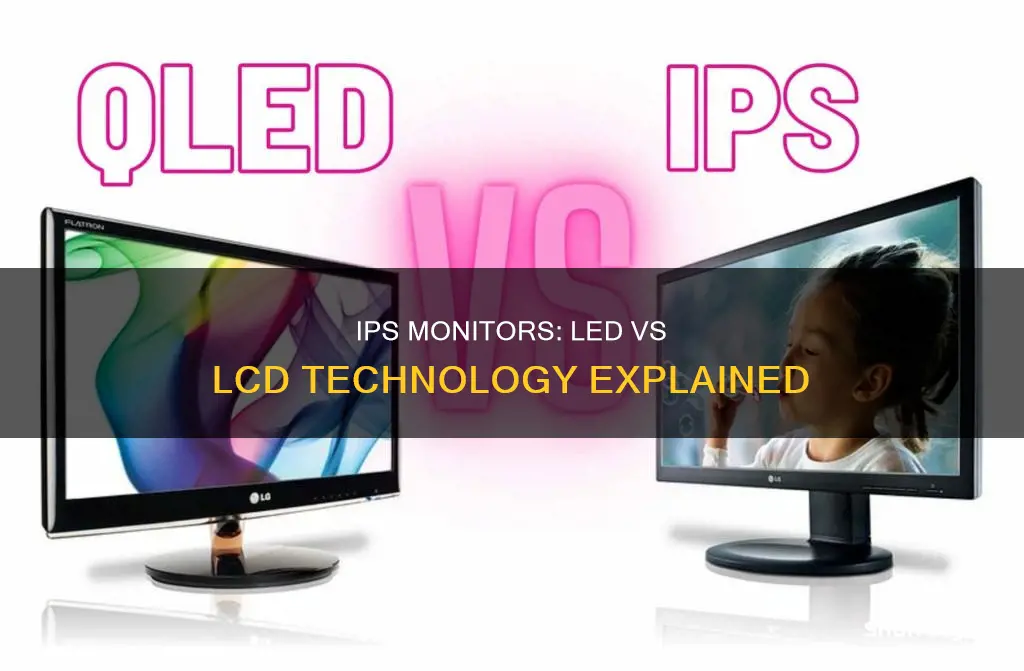
IPS and LED monitors are two of the most common types of display technologies available today. While both are based on LCD (Liquid Crystal Display) screens, they differ in their backlight technologies and panel types. LED (Light-Emitting Diode) monitors use LEDs as a backlight to illuminate individual pixels, offering brighter screens and lower power consumption. On the other hand, IPS (In-Plane Switching) is a type of LCD panel technology known for its superior colour accuracy and wide viewing angles. IPS panels are often compared with TN (Twisted Nematic) and VA (Vertical Alignment) panels, offering better image quality at a higher price point. While IPS monitors are preferred for graphics-intensive tasks and video editing, LED monitors are popular for gaming due to their lower response times and affordable pricing.
| Characteristics | Values |
|---|---|
| Type | IPS: Panel Technology |
| LED: Backlight Technology | |
| Image Quality | IPS: High quality, detailed, vibrant, crisp |
| LED: Bright, less colour accuracy | |
| Viewing Angles | IPS: Wide, consistent colour from all angles |
| LED: Limited, colour washes out at certain angles | |
| Response Time | IPS: Slower, improving over time |
| LED: Faster | |
| Power Consumption | IPS: Higher |
| LED: Lower | |
| Heat Production | IPS: Higher |
| LED: Lower | |
| Cost | IPS: More expensive |
| LED: Affordable |
What You'll Learn

IPS monitors are a type of LCD panel technology
IPS panels were developed to address the shortcomings of other panel types, such as poor viewing angles and limited colour reproduction. As a result, IPS panels offer significantly wider viewing angles and more lifelike and vibrant colours than their TN (twisted nematic) and VA (vertical alignment) counterparts. They are also superior in terms of colour accuracy and image quality.
However, IPS panels tend to be pricier than TN and VA panels, and they are not as fast and responsive. They also cannot offer the same kind of contrast as VA panels.
IPS monitors are perfect for graphically stunning games, content creation, and professionals who work with image and video editing.
Nevada Power Co: Monitoring Customer Usage and Bills?
You may want to see also

LED monitors are a type of backlight technology
The benefit of using LED panel technology is the brightness of the LED displays while maintaining an efficient energy consumption lower than other screen technologies. LED monitors are often less expensive, feature a broader dimming range, are generally considered quite reliable, feature a higher dynamic contrast ratio, and are less impactful on the environment.
There are two types of LED backlight in the context of LCD displays: edge-lit LEDs and direct-lit LEDs. Edge-lit LEDs are positioned around the edges of the screen, while direct-lit LEDs are positioned behind the screen. The former are more power-efficient and are some of the thinnest LCDs available, but they might not be as bright as direct-lit LED displays. Direct-lit LEDs, on the other hand, offer better backlight uniformity and higher overall brightness, but they are bulkier and their contrast isn't as great.
IPS (in-plane switching) is a type of LCD panel manufacturing technology. IPS panels are known for their colour accuracy and large viewing angles when compared to other types of display panels. They are revered as the best option for graphics professionals. IPS panels were considered a failure a few years ago, but now they are the cutting-edge technology of today.
While LED monitors are generally more affordable, IPS monitors are way more expensive. People who are into content creation, video editing, and image editing invest in IPS monitors as they deliver clear and crisp images for accurate edits.
In summary, LED monitors offer a range of benefits such as low energy consumption, durable backlights, and vivid images, while IPS screens have the advantage of superior picture quality.
Monitoring Memory Usage: Tips and Tricks for Developers
You may want to see also

IPS monitors are more expensive
IPS monitors are generally more expensive than other types of monitors, such as TN (Twisted Nematic) and VA (Vertical Alignment) panels. This is due to the advanced technology used in IPS monitors, which offer better colour reproduction and wider viewing angles. This makes them a preferred choice for professionals in graphic design, photography, and video editing, who require accurate colours and consistent visuals from different angles.
IPS stands for In-Plane Switching, and these monitors were developed by Hitachi in the 1990s to address the limitations of TN panels, particularly their narrow viewing angles and poor colour reproductions. Over the years, IPS technology has continued to evolve, with companies like LG and Samsung driving innovations. Today, IPS monitors are highly sought after for their superior colour accuracy, wide viewing angles, and faster response times, which are crucial for gamers and video editors.
The complex manufacturing process and high-quality materials required for IPS monitors contribute to their higher price tag. Additionally, IPS monitors have lower contrast ratios and are not as bright as other panel types, which can be a drawback for users who frequently watch movies or play games in dark environments. Despite these limitations, the benefits of IPS monitors often outweigh the negatives for those who prioritise colour accuracy and wide viewing angles.
IPS monitors are also known for their high refresh rates, ensuring smooth and seamless motion. This makes them ideal for gaming and watching fast-paced videos. Furthermore, IPS monitors provide deep black levels and high contrast ratios, resulting in a more immersive viewing experience. The combination of these advanced features and their superior performance justifies the higher cost of IPS monitors compared to other types of displays.
Monitoring ACE Inhibitor Usage: Strategies for Safe Prescribing
You may want to see also

LED monitors are more power-efficient
The power efficiency of LED monitors is due in part to the type of backlighting technology they use. LED monitors use light-emitting diodes for backlighting, while IPS monitors typically use fluorescent panels or cold cathode fluorescent lamps (CCFLs). This difference in backlighting technology also contributes to the longer lifespan of LED monitors compared to IPS monitors. The backlights of LED monitors typically last 50,000 to 100,000 hours, while CCFL backlights in IPS monitors last around 30,000 to 60,000 hours.
Additionally, LED monitors offer superior picture quality with better contrast ratios and deeper blacks compared to IPS monitors. They also have wider viewing angles, meaning colours and contrast remain more consistent when viewing the screen from different angles. This makes LED monitors a popular choice for gaming, graphic design, and video editing.
While IPS monitors may offer better image quality and colour accuracy, they require more power to maintain this performance. IPS monitors are perfect for graphically stunning games, creating content, or for professionals who need accurate colour reproduction for their work. However, their higher power consumption can lead to increased heat output and potentially shorter lifespans.
In summary, LED monitors are more power-efficient than IPS monitors due to their lower power requirements, brighter displays, and longer-lasting backlights. This makes them a more common choice for LCD backlighting technology today.
Finding the Perfect Duo Monitor: Size Considerations
You may want to see also

IPS monitors offer wider viewing angles
IPS stands for In-Plane Switching, and its screens have better image quality than Vertical Alignment and Twisted Nematic panel types. The images on IPS displays are typically detailed and vibrant due to their colour accuracy.
IPS monitors deliver ultra-wide 178-degree vertical and horizontal viewing angles. This means that even those sitting at the very edge of the room will have a clear view of the picture.
IPS monitors are perfect for graphic designers, CAD engineers, pro photographers, and video editors who will benefit from the colour benefits of IPS monitors.
IPS monitors are also great for gaming. Tech advances have improved IPS panel speed, contrast, and resolution, making them more attractive than ever for general desktop work and gaming.
IPS monitors are more expensive than LED monitors, but the extra cost is worth it for the improved viewing angles and image quality.
Enhancing Your ASUS GeForce GT 710 Monitor Experience
You may want to see also
Frequently asked questions
IPS (In-Plane Switching) is a type of LCD (Liquid Crystal Display) panel manufacturing technology. IPS panels are known for their superior colour accuracy and large viewing angles compared to other types of display panels.
IPS is a panel technology, while LED is a type of backlight. IPS monitors are about high-quality visuals, whereas LED monitors are about brightness.
IPS monitors are considered better for your eyes as they offer decent colour representation and excellent contrast ratios, reducing the effort your eyes need to make to decipher things.
IPS monitors are more expensive than LED monitors. They are aimed at those who need the most accurate colour production and highest-quality images, such as graphics professionals and content creators.







